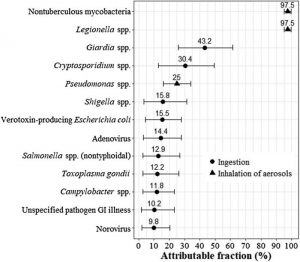
Hi all…I hope you are all well! While the focus on disease these days is understandably COVID-19, a study entitled “Estimates of healthcare utilisation and deaths from waterborne pathogen exposure in Ontario, Canada” was recently published in the journal ‘Epidemiology and Infection’. The study estimated the disease burden attributable to nine enteric pathogens, unspecified pathogens leading to gastroenteritis, and three opportunistic pathogens leading primarily to respiratory illness. There is a lot of information in this paper but one of the more interesting (and perhaps not surprising) findings is that “when a causative pathogen was specified, the majority of hospitalisations (83%) and deaths (97%) resulted from exposure to the opportunistic pathogens Legionella spp., non-tuberculous mycobacteria and Pseudomonas spp.”
Bill
_____________________________________________
Estimates of healthcare utilisation and deaths from waterborne pathogen exposure in Ontario, Canada
Greco SL, Drudge C, Fernandes R, Kim JinH, Copes R (2020)
Epidemiology and Infection 148, e70, 1–10. https://doi.org/10.1017/ S0950268820000631
https://www.ncbi.nlm.nih.gov/pmc/articles/PMC7118719/
Abstract
“Burden of disease analyses can quantify the relative impact of different exposures on population health outcomes. Gastroenteritis where the causative pathogen was not determined and respiratory illness resulting from exposure to opportunistic pathogens transmitted by water aerosols have not always been considered in waterborne burden of disease estimates. We estimated the disease burden attributable to nine enteric pathogens, unspecified pathogens leading to gastroenteritis, and three opportunistic pathogens leading primarily to respiratory illness, in Ontario, Canada (population ∼14 million). Employing a burden of disease framework, we attributed a fraction of annual (year 2016) emergency department (ED) visits, hospitalisations and deaths to waterborne transmission. Attributable fractions were developed from the literature and clinical input, and unattributed disease counts were obtained using administrative data. Our Monte Carlo simulation reflected uncertainty in the inputs. The estimated mean annual attributable rates for waterborne diseases were (per 100 000 population): 69 ED visits, 12 hospitalisations and 0.52 deaths. The corresponding 5th–95th percentile estimates were (per 100 000 population): 13–158 ED visits, 5–22 hospitalisations and 0.29–0.83 deaths. The burden of disease due to unspecified pathogens dominated these rates: 99% for ED visits, 63% for hospitalisations and 40% for deaths. However, when a causative pathogen was specified, the majority of hospitalisations (83%) and deaths (97%) resulted from exposure to the opportunistic pathogens Legionella spp., non-tuberculous mycobacteria and Pseudomonas spp. The waterborne disease burden in Ontario indicates the importance of gastroenteritis not traced back to a particular pathogen and of opportunistic pathogens transmitted primarily through contact with water aerosols.”





